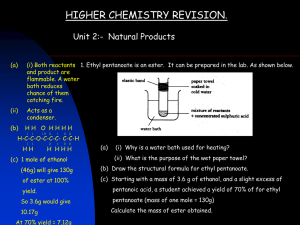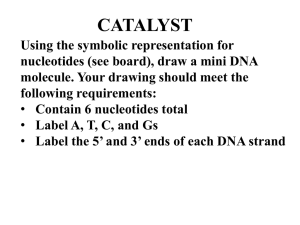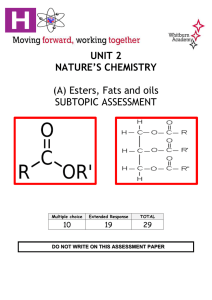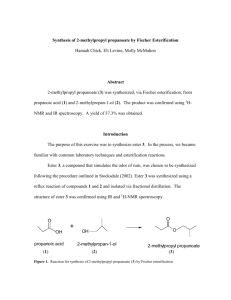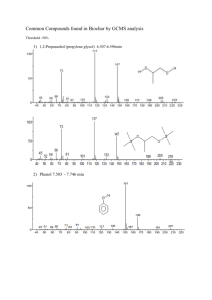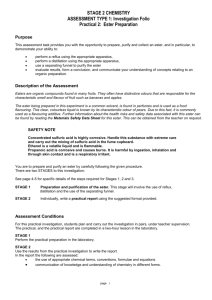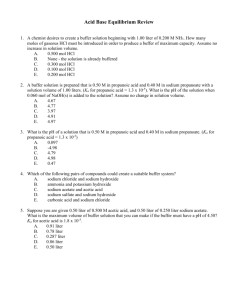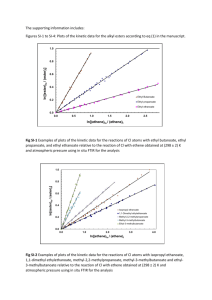Unit 2 Natural Products
advertisement
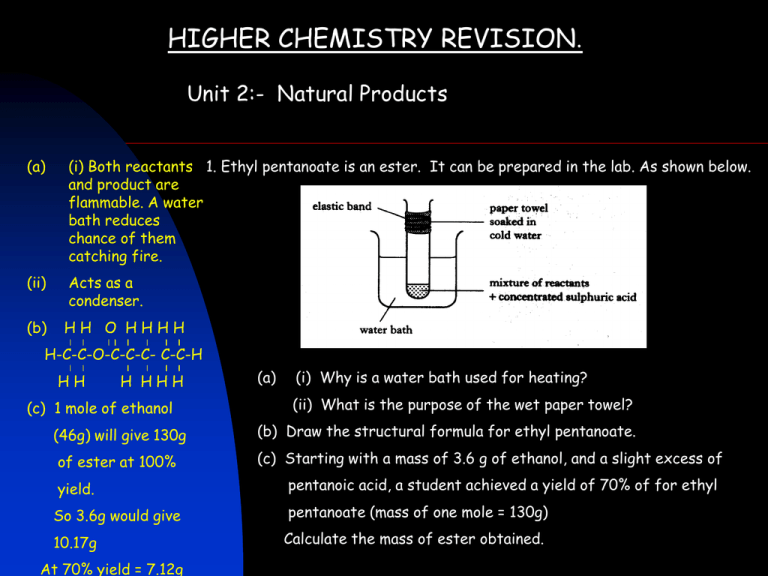
HIGHER CHEMISTRY REVISION. Unit 2:- Natural Products (a) (i) Both reactants 1. Ethyl pentanoate is an ester. It can be prepared in the lab. As shown below. and product are flammable. A water bath reduces chance of them catching fire. (ii) Acts as a condenser. (b) HH O HHHH H-C-C-O-C-C-C- C-C-H HH H HHH (c) 1 mole of ethanol (a) (i) Why is a water bath used for heating? (ii) What is the purpose of the wet paper towel? (46g) will give 130g (b) Draw the structural formula for ethyl pentanoate. of ester at 100% (c) Starting with a mass of 3.6 g of ethanol, and a slight excess of yield. pentanoic acid, a student achieved a yield of 70% of for ethyl So 3.6g would give pentanoate (mass of one mole = 130g) 10.17g Calculate the mass of ester obtained. At 70% yield = 7.12g 2. Proteins are an important part of a balanced diet. Identify the two true statements. A Proteins are a more concentrated energy source than carbohydrates. B Proteins are made by addition polymerisation. C Denaturing of proteins involves changes in the structure of the molecules. D Globular proteins are the major structural materials in animal tissues. E Proteins are compounds of nitrogen, carbon, hydrogen and oxygen. 3. The structure of a molecule found in olive oil can be represented as shown 2. C and E 3. (a) (i) Heterogeneous. (ii) Fat is saturated, (b) (i) Glycerol or propane-1,2,3-triol. (ii) Soap. (a) Olive oil can be hardened using a nickel catalyst to produce a fat. (i) What type of catalyst is nickel in this reaction? (ii) In what way does the structure of a fat molecule differ from that of an oil molecule? (b) Olive oil can be hydrolysed using sodium hydroxide solution to produce sodium salts of fatty acids. (i) Name the other product of this reaction. (ii) Give a commercial use for sodium salts of fatty acid. 4. An ester can be prepared by the following sequence of reactions. H H H H H– C–C–C– C–H H H Br H step 1 HBr removed Compound A CH3 – CH=CH-CH3 but-2-ene step 2 (a) CH3-CH2CH=CH2 (b) Addition or hydration (c) Orange to green (d) Butanoic acid (e) Oily layer formed (f) Solvents, perfume bases. step 2 CH3-CH2CH2CH2-OH CH3-CH2-CH-CH3 OH step 3 oxidation Compound B step 4 condensation (a) Draw the structural formula for compound A Ester (d) Name compound B. (b) What kind of reaction is shown by step 2? (e) What evidence would show that an ester had been (c) What colour change would be seen when acidified dichromate is used to carry out step 3. formed in step 4? (f) Give one use for esters. 5. Tooth enamel contains a fibrous protein called collagen. (a) Describe the difference between a fibrous protein and a globular protein. (b) Name the four elements present in all proteins. (a) Fibrous proteins are long, parallel protein chains with occasional cross links making up fibres. Globular proteins are folded into complex, almost spherical shapes. (b) Carbon, hydrogen, oxygen and nitrogen. 6. Biodiesel is a mixture of esters which can be made by heating rapeseed oil with methanol in the presence of a catalyst. C21H39 —C—O—CH2 C21H39 —C—O—CH + 3CH3OH 3 C21H39 —C—O—CH3 + X C21H39 —C—O—CH2 a triglyceride in Methanol rapeseed oil a component of biodiesel (a) Name compound X (b) A typical diesel molecule obtained from crude oil has the molecular formula C16H34 (hexadecane). Other than the ester group, name a functional group present in biodiesel molecules which is not present in hexadecane. (c) Vegetable oils like rapeseed oil are converted into fats for use in the food industry. What name is given to this process? (a) Glycerol OR propane-1,2,3-triol. (b) C=C double bond. (c) Hydrogenation. 7. All enzymes are globular proteins. (a) What term is used to describe proteins which are not globular? (b) Catalase is an enzyme, contained in potatoes. A student was studying the effect of varying pH on the activity of catalase. The following apparatus was set up and left for 3 minutes. (i) What must be added to the side-arm test tube to study the enzyme activity at this pH? (ii) Describe how the enzyme activity at this pH can be measured. (a) Fibrous. (b) (i) Hydrogen peroxide solution. (ii) Counting the number of bubbles of oxygen in a set time can give a measure of the enzyme activity. The more active the enzyme o greater the number of bubbles of oxygen gas given off. 8. Two reactions of propanoic acid are shown. (a) Draw a structural formula for ester X. (b) (i) Give a name for compound Y, which reacts with propanoic acid to form sodium propanoate. (ii) Explain why solutions of sodium propanoate are alkaline. (a) O CH3-CH2 –C-O-CH3 (b) (i)Sodium hydroxide. (ii) Sodium propanoate is salt of weak acid and strong base. Propanoate and hydrogen ions in solution combine to form molecules of propanoic acid. This removes hydrogen ions leaving water with an excess of hydroxide ions from water dissolciation. H2O(l) H+(aq) + OH-(aq)
